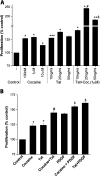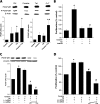Effect of cocaine on human immunodeficiency virus-mediated pulmonary endothelial and smooth muscle dysfunction
- PMID: 20802087
- PMCID: PMC3145070
- DOI: 10.1165/rcmb.2010-0097OC
Effect of cocaine on human immunodeficiency virus-mediated pulmonary endothelial and smooth muscle dysfunction
Abstract
Human immunodeficiency virus (HIV)-associated pulmonary arterial hypertension (PAH) is a devastating, noninfectious complication of acquired immune deficiency syndrome, and the majority of HIV-PAH cases occur in individuals with a history of intravenous drug use (IVDU). However, although HIV-1 and IVDU have been associated with PAH independently or in combination, the pathogenesis of the disproportionate presence of HIV-PAH in association with IVDU has yet to be characterized. The objective of this study was to obtain a better understanding of the interactions between HIV-1 and cocaine to help uncover the mechanism(s) of the development of HIV-PAH. We observed that exposure of HIV-infected macrophages or HIV-Trans-Activator of Transcription (Tat)-treated pulmonary endothelial cells to cocaine enhanced the expression of platelet-derived growth factor (PDGF)-BB. Simultaneous treatment with Tat and cocaine, on the other hand, exacerbated both the disruption of tight junction proteins (TJPs), with enhanced permeability in pulmonary endothelial cells, and the proliferation of pulmonary smooth muscle cells (pSMCs) compared with either treatment alone. Histological examination of HIV plus IVDU human lung sections showed signs of early pulmonary arteriopathy, severe down-modulation of TJPs, and increased expression of PDGF-BB compared with the lung sections from individuals who are infected with HIV and without history of IVDU. Interestingly, blocking of PDGF receptor signaling with the receptor antagonist or small interfering RNA has been shown to inhibit the increase in proliferation of pSMCs on Tat and cocaine exposure. Our results, therefore, support an additive effect of cocaine to HIV infection in the development of pulmonary arteriopathy through enhancement of endothelial dysfunction and proliferation of pSMCs, while also suggesting PDGF-PDGF receptor axis as a potential target for use in clinical intervention.
Figures








Similar articles
-
Hypoxia-inducible factor-1 α/platelet derived growth factor axis in HIV-associated pulmonary vascular remodeling.Respir Res. 2011 Aug 5;12(1):103. doi: 10.1186/1465-9921-12-103. Respir Res. 2011. PMID: 21819559 Free PMC article.
-
Downregulation of bone morphogenetic protein receptor axis during HIV-1 and cocaine-mediated pulmonary smooth muscle hyperplasia: implications for HIV-related pulmonary arterial hypertension.Arterioscler Thromb Vasc Biol. 2013 Nov;33(11):2585-95. doi: 10.1161/ATVBAHA.113.302054. Epub 2013 Sep 5. Arterioscler Thromb Vasc Biol. 2013. PMID: 24008158 Free PMC article.
-
HIV-1/cocaine induced oxidative stress disrupts tight junction protein-1 in human pulmonary microvascular endothelial cells: role of Ras/ERK1/2 pathway.PLoS One. 2014 Jan 7;9(1):e85246. doi: 10.1371/journal.pone.0085246. eCollection 2014. PLoS One. 2014. PMID: 24409324 Free PMC article.
-
Pulmonary Immune Dysregulation and Viral Persistence During HIV Infection.Front Immunol. 2022 Jan 4;12:808722. doi: 10.3389/fimmu.2021.808722. eCollection 2021. Front Immunol. 2022. PMID: 35058937 Free PMC article. Review.
-
Future directions: lung aging, inflammation, and human immunodeficiency virus.Clin Chest Med. 2013 Jun;34(2):325-31. doi: 10.1016/j.ccm.2013.01.010. Epub 2013 Apr 8. Clin Chest Med. 2013. PMID: 23702180 Free PMC article. Review.
Cited by
-
Pulmonary Function in HIV-Infected Recreational Drug Users in the Era of Anti-Retroviral Therapy.J AIDS Clin Res. 2014 Nov;5(11):365. doi: 10.4172/2155-6113.1000365. J AIDS Clin Res. 2014. PMID: 25664201 Free PMC article.
-
Effect of Cocaine on Pulmonary Vascular Remodeling and Hemodynamics in Human Immunodeficiency Virus-Transgenic Rats.Am J Respir Cell Mol Biol. 2016 Aug;55(2):201-12. doi: 10.1165/rcmb.2015-0264OC. Am J Respir Cell Mol Biol. 2016. PMID: 26820592 Free PMC article.
-
Hypoxia-inducible factor-1 α/platelet derived growth factor axis in HIV-associated pulmonary vascular remodeling.Respir Res. 2011 Aug 5;12(1):103. doi: 10.1186/1465-9921-12-103. Respir Res. 2011. PMID: 21819559 Free PMC article.
-
Hyperactive TGF-β Signaling in Smooth Muscle Cells Exposed to HIV-protein(s) and Cocaine: Role in Pulmonary Vasculopathy.Sci Rep. 2017 Sep 5;7(1):10433. doi: 10.1038/s41598-017-10438-3. Sci Rep. 2017. PMID: 28874783 Free PMC article.
-
Enhanced pulmonary arteriopathy in simian immunodeficiency virus-infected macaques exposed to morphine.Am J Respir Crit Care Med. 2012 Jun 1;185(11):1235-43. doi: 10.1164/rccm.201110-1909OC. Epub 2012 Mar 23. Am J Respir Crit Care Med. 2012. PMID: 22447963 Free PMC article.
References
-
- Barbaro G, Lipshultz SE. Pathogenesis of HIV-associated cardiomyopathy. Ann N Y Acad Sci 2001;946:57–81. - PubMed
-
- Bauersachs J, Bouloumie A, Fraccarollo D, Hu K, Busse R, Ertl G. Endothelial dysfunction in chronic myocardial infarction despite increased vascular endothelial nitric oxide synthase and soluble guanylate cyclase expression: role of enhanced vascular superoxide production. Circulation 1999;100:292–298. - PubMed
-
- Kitayama J, Faraci FM, Lentz SR, Heistad DD. Cerebral vascular dysfunction during hypercholesterolemia. Stroke 2007;38:2136–2141. - PubMed
-
- Dobbs MR, Berger JR. Stroke in HIV infection and AIDS. Expert Rev Cardiovasc Ther 2009;7:1263–1271. - PubMed
Publication types
MeSH terms
Substances
Grants and funding
LinkOut - more resources
Full Text Sources
Medical

